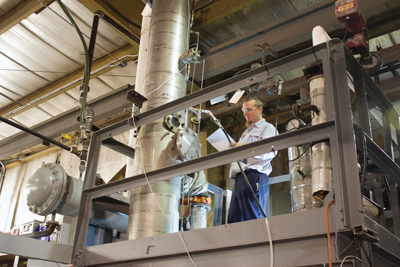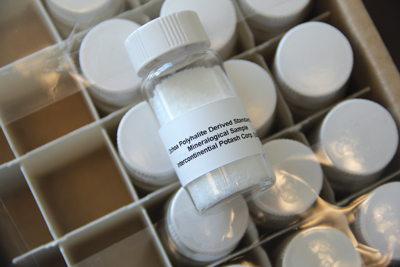 |
| IC Potash turned to Veolia Water Technologies for refinement and validation of a proprietary process to produce high-quality crystallized sulphate of potash. |
Growing worldwide demand for agricultural products is increasing demand for potash, a major source of the potassium that is a primary nutrient in plant growth. Most of the potash produced in the U.S. comes from southeastern New Mexico, home to one of the world’s largest known concentrations of sedimentary potash deposits. The region’s output is likely to be boosted even further through a proposal by Canada’s IC Potash to produce sulphate of potash, or SOP, a specific potassium fertilizer especially beneficial for fruits and vegetables as well as for salt-sensitive soils.
The company’s Ochoa project would mine potassium-rich polyhalite and process the ore to produce SOP using a unique, low-cost method dating back to research conducted in the 1920s by the U.S. government. The studies were part of an effort to reduce American dependence on imported potash after a German embargo during World War I. SOP production of polyhalite was ultimately pushed aside when alternative potash sources were developed in the years that followed.
 |
| IC Potash turned to Veolia Water Technologies for refinement and validation of a proprietary process to produce high-quality crystallized sulphate of potash. |
Now, however, the increased global consumption of fruits and vegetables, which are sensitive to the chloride found in regular potash, has created a new demand for an economical source of SOP. With its Ochoa mine and mill, IC Potash aims to meet the world market demand with an affordable supply of premium-quality SOP fertilizer produced from natural sources.
Refined from the original government studies, IC Potash’s proprietary Ochoa Process is based on polyhalite, water and energy. The mined ore is crushed and washed, than calcined to recover potassium sulphate. The calcined ore is then subjected to leaching, producing a brine that is crystallized to produce SOP. The crystallized SOP is then dried, sized and granulated to produce SOP in its three marketed forms: soluble, standard and granular.
Crystallization of the brine is critical for controlling production costs and ensuring product quality. To refine and validate this and other process steps in order to confirm the commercial design, IC Potash turned to Veolia Water Technologies for its expertise in designing and implementing processes for evaporation and crystallization.
 |
| Exploration drilling of the Ochoa potash deposit began with rotary drilling down to the target formation, then core drilling through the cased rotary hole. |
To validate the overall design, Veolia conducted a series of tests to simulate various stages using its HPD Technology, part of the innovative process solutions provided to leading producers of fertilizer worldwide. A pilot test performed at the company’s HPD Evaporation and Crystallization Research and Development Center near Chicago, Illinois, replicated the full Ochoa potassium sulphate crystallization process demonstrated previously through bench tests.
The pilot was designed to confirm and optimize the evaporation and crystallization stages as well as the upstream leaching pre-treatment process to validate that the quality and purity of the product could be achieved.
Process elements verified and optimized included:
• Calcined polyhalite leach process and composition of feed to the Veolia process equipment;
• Dissolution and pre-concentration of leonite, a crystallized mineral produced in the later stages of the process, brought forward in the system to increase the recovery of potassium sulphate;
• Leonite crystallization using a triple effect HPD Crystallizer System to maximize recovery from the SOP Crystallizer purge stream. The leonite slurry is sent to the centrifuge with the solids then fed back into the production loop to be combined with the leach brine at the beginning of the process;
• Countercurrent leaching process to produce the brine;
• Leonite solids dissolution tank;
• Seeded, mechanical vapor re-compression HPD (MVR) Evaporator to provide bulk water removal from the leonite enriched brine;
• Filtration step to remove precipitated solids;
• HPD (MVR) Crystallizer (SOP crystallizer) to produce a slurry of pure SOP;
• Centrifuge to separate SOP product from slurry; and
• Dryer, fed with solids from the centrifuge, to yield a granular, crystalline product.
The pilot confirmed the technical viability of the process and helped define the parameters going forward with results that were “better than expected,” said IC Potash CEO Sid Himmel. The SOP crystals produced in the pilot tests grew to a size and habit of those in the prior bench-scale testing, and heat transfer surfaces showed no fouling in the process equipment.
The results of the collaboration between ICP and Veolia provided the confidence that a commercial system would perform as designed, meeting product quality and Veolia product performance guarantees. With Veolia’s help, IC Potash is now preparing for the front-end engineering and design, and the refinement of cost estimates to confirm the project’s economic feasibility. Veolia will continue its involvement in providing its complete evaporation and crystallization process solutions, said Himmel, who praises the company’s technical capabilities and “commitment to finding solutions for customers.”
As Himmel continues to talk with investors to raise the estimated $1 billion needed to build the mine, interest is bolstered by the strong market interest in the new SOP supply. “The demand drivers are the best for any commodity and we’re going to meet it with the lowest cost natural source production in the world,” he said. Already, a commitment has been received from one of the world’s largest fertilizer producers for 30% of Ochoa’s projected annual 700,000 tons of production, scheduled to begin in 2017, and additional inquiries regarding production have been received.









